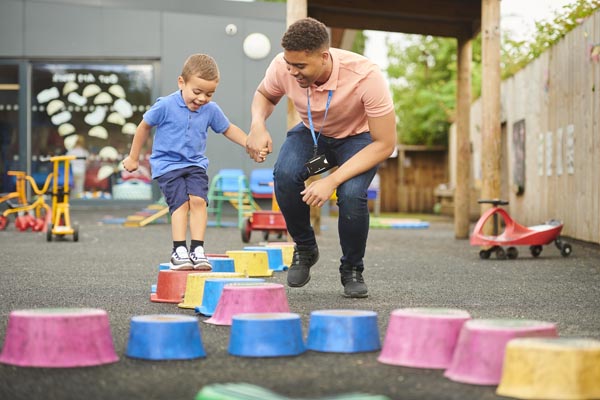Free Play

Play (Free Play) is an activity someone chooses for themselves simply because they want to do it—that is, the activity is intrinsically motivated. The person is doing the activity for the internal satisfaction experienced from the activity – versus doing the activity for an external reward e.g., money or to gain someone’s approval. Scientists say play is a self-selected, self-directed activity that is structured by the player. On this site we call this simply “play”, or “free play” – because play is freely chosen by the players.
Play is an activity that is 100% playful. Children, unencumbered by life responsibilities, easily reach the state of free play. Look at the boy jumping over a pile of leaves, he is in a 100% totally engaged, playful state that he chose and that he is directing. That is free play.
A key point here is that activities that are directed by another person and activities that we pursue for an external (vs internal) reward, are not play. They may be to varying degrees playful, but they are not, by objective definition, play or free play.
NIFP and Dr. Brown reserve the word “play” for an activity that includes all of Dr. Peter Gray’s (p.140) five elements of play:
- Self-chosen and self-directed;
- Intrinsically motivated (that is, the means are more valued than the ends);
- Structured or ordered based on rules in the player’s mind;
- Imaginative, or has a creative aspect); and
- A playful state of mind—the player is very engaged, alert, mentally active, and focused on the activity, but is not stressed about the activity (they have no fear of judgment, and there are no consequences that matter outside of the activity itself).
More on definition of play by Dr. Gray
Free play is most common in children; they are far less constrained by the responsibilities that accumulate as we grow older. In free play, children follow what naturally engages them. Children playing are doing things they are innately motivated to do -activities they just want to do; because their chosen activities are innately motivated, they want to do them over and over.
In adults, playfulness most often blends with other attitudes and motivations having to do with adult responsibilities. Adult activities can be quite playful, and there can be a great deal of internal satisfaction felt from those activities. However adults seldom if ever get to the 100% playful state that happens so often in childhood.
The degree to which an activity is engaging, self-chosen, self-directed, internally motivated and internally rewarding contributes to a subjective sense of how playful the activity is. An activity that meets all five of the above criteria fully is 100% playful or what we call play. Now there are not objective, repeatably measurable metrics for these factors (yet), but generally if an activity meets many of them and it is something that one wants to do again and again, then those activities put us in what Dr. Brown calls a “state of play.”

Play can be solitary (reading, collecting or creating), or social. Groups of players may be of similar ages or skill levels (children jumping rope or adults playing bridge). When children of different ages or skill levels are playing together, we refer to it as “mixed-age play”
Mixed-age play is qualitatively different from same-age play. In mixed-age play each child tries to do their best but has little or no concern for beating others. Mixed-age play enables younger kids to learn skills and more sophisticated ways of doing things from older kids. In turn, the older children benefit from learning how to nurture, lead, and be the mature person in a relationship (Gray pp. 35 & 181-186). With adults who are playing, mixed skill levels enable the less skilled adults to learn from those more skilled.
When multiple children are involved, free play involves consensus of choices on the activity and the structure of the activity. Anyone participating without feeling in agreement with the rules isn’t fully engaged and not really playing. More on mixed-age play.
An activity stops being play for the participants the moment a non-participant (e.g., an adult) questions the players’ choices or outright directs the activity.
Free play is critical to healthy development of children, especially young children. For adults, play and playfulness are central to equanimity and well-being.
Directed Playful Activities

Children’s activities directed by an adult can be playful and fun, but since they are not self-chosen or self-directed they are not fully play. Those who experience an activity directed by someone else as playful are engaged in the activity; those who do not experience playfulness during the activity are most likely not bought in, not engaged in the activity.
Examples of directed playful activities include playful classroom lessons led by teachers to facilitate learning and recess or after-school activities organized by teachers or other adults. These activities can be fun, may develop the social-emotional skills of the children participating, and can create a sense of belonging for the children that fully buy in (are engaged by the activity). But these activities are not self-chosen and self-directed and some children will not be engaged in them; for those children the activity is not playful let alone play. Children not engaged and playfully participating in the activity will not accrue the learning, SEL (socio-emotional learning) and belonging benefits that those who are engaged receive. More on adult directed activities by Dr. Gray











